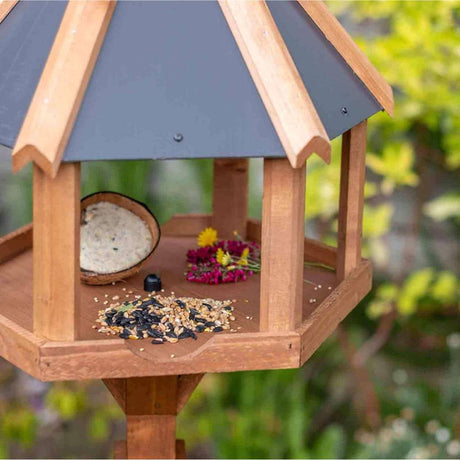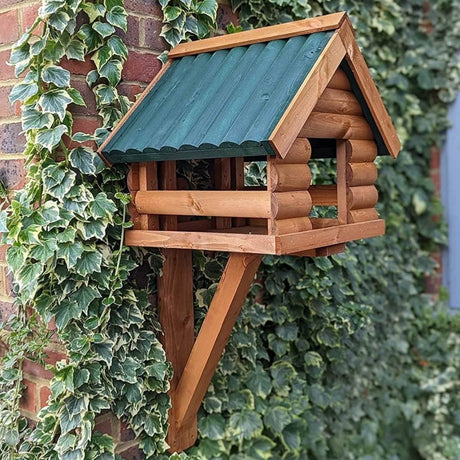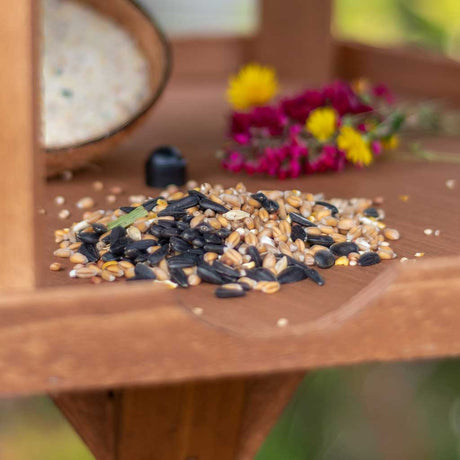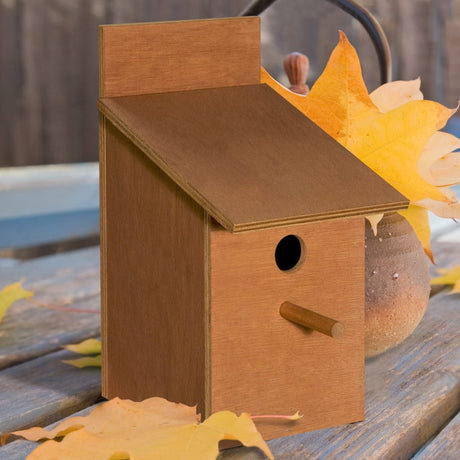Before we look at how to help baby birds, let's try and figure out when a bird is a baby and when we might think of it more as a stroppy teenager or even a little adult.
How Long Do Baby Birds Spend In the Nest?
The time that baby birds spend in the nest varies enormously depending on the species.
Ducklings and the chicks of many wading birds hatch nicely insulated in fluff and ready to waddle off straight away. Ducklings will be fed and cared for by their parents for a while. But they don't spend any time confined to the nest. Leaving home so soon, of course, is much easier when your nest is on the ground rather than up a tree, and leaving the nest doesn't require you to have the feathers and muscles for flight.
At the other end of the scale, many of the raptors, hawks, and eagles continue to feed their young in the nest for months before they finally fledge and take their first flight.

The young of most of our garden birds, though, stay in the nest for 2 to 3 weeks. Garden bird chicks generally hatch featherless and tiny. Their time as nestlings is spent in a feeding frenzy, where many of them will increase their size up to 10 fold as well as growing feathers, before taking their first flight from the nest.
How to Help a Nestling
If you find a nestling out of its nest, it will most certainly need your help.
First, be sure that it is a nestling and not an older fledgeling. You can tell because a nestling will have few or no feathers. If it looks like this, then it has probably fallen from the nest. In some circumstances, parents will still try to feed a fallen nestling. But if it's on the ground, it is so vulnerable to predators that it's unlikely to survive.

Here's what you should and shouldn't do to help a nestling.
Don't: try to replace the bird in the nest. You may pick the wrong nest. Even if you get the right nest, the parents may consider that the nest has been disturbed if you have touched it and abandon all the chicks. And sometimes, if the nestling is ill, the parents will have deliberately ejected it from the nest to give the others a better chance of survival.
Don't offer the baby bird food or water. At this stage of development, their digestion is very fragile. Offering the wrong food or liquids could do more harm than good.
Don't: touch the baby bird with your bare hands any more than you need to. Try to use gloves or a towel.
Do: get the nestling to a local animal hospital or rescue centre as soon as possible.
Do: place it in a ventilated cardboard box lined with newspaper or an old towel and put the box in a warm, quiet, dark place until you get the bird to help.
How Long Do Parents Look After Fledglings?
As with time in the nest, the time that parents look after fledgelings varies significantly from species to species.
Some species, like the cuckoo, offer no parental care at all; they don't even sit on their own eggs.
Tits and sparrows may spend just a couple of days after leaving the nest with their parents before being left to their own devices. This is thought to be due to the easy availability of suitable food.
Swans, on the other hand, take care of their young for six to nine months. And some members of the crow or corvid family continue to care for their chicks for over a year. This is thought to be part of the reason crows are so smart: they get a lot of schooling.
I love the family set-up of the house martin. They will have 2 or three broods each year, and young birds from the first brood frequently stick around to help raise their younger siblings. Imagine - helpful teenagers!
Most of the birds we see in our gardens will continue to feed and educate their young for 2 to 3 weeks after they leave the nest.

It's at this stage, when chicks still look like baby birds, with scruffy feathers, unsure movements and limited flight, that many well-meaning people see them alone and think they need help.
When Do Fledgelings Need Our Help?
The RSPCA reports an 80% increase in the numbers of fledgelings brought in to them for help in recent years. It's great that we are clearly paying more attention to the welfare of our wildlife. But removing a healthy bird from the wild unnecessarily reduces its chances of long term survival dramatically. This is a crucial time for learning and development: the young bird needs its parents and its natural environment.
Additionally, our rescuers and animal hospitals have limited resources. A space taken by a healthy fledgeling could be used by another animal in real trouble.
So how do we know if fledgelings need our help?
The truth is that most of the time, fledgelings don't need help and will be better left alone. Certainly, this is a hazardous life stage for them. They are inexperienced, have limited flight ability, are an easy target for predators and may struggle to find the food they need to survive.

But in most bird species, when adults have built a nest, laid and hatched eggs and fed chicks in the nest for weeks, they are fully invested in their offspring. Even though the fledgeling may seem to be on its own, the parents are likely to be near.
If the baby bird appears to be in immediate danger, or the edge of a road maybe, you might nudge it out of the way, towards the undergrowth. Don't move it any further than you need to. Parents and Yong find each other through calling, so don't move the baby out of hearing distance of its original site.
If the bird is visibly injured, bleeding, can't stand or is cold and shivering, then it needs your help. Box it up following the instructions above, and contact your local rescuers.
But if the fledgeling appears fit and healthy and is alone, there is almost certainly no need to intervene. Observe the bird from a distance for at least 2 hours. Once you are out of the picture, one or both of the parents will almost certainly appear.
If, after observation, you are 100% certain the fledgeling is an orphan, then once again box it up securely and keep it warm and quiet whilst you contact your local rescue.
What if I Disturb a Nest?
If you accidentally disturb a nest, try to put it back exactly as it was as quickly and quietly as possible and leave it in peace.
Even if the nest is somewhere inconvenient, like in a barbecue you wanted to use, or a border you were planning to cut back, you must leave it be until the eggs have hatched and the chicks have fledged. Remember, this will only be a few weeks.

There is a chance that you disturbing the nest may cause the parents to abandon it. So try to observe the site from a distance to check for signs of adults coming and going. If a nest with live chicks has been abandoned, you should contact local rescuers as soon as possible.
Making Your Garden Baby Bird-Friendly
There are a few things you can do to help baby birds in your garden and make it a hospitable environment for nestlings and fledgelings.
Keep the Cats Out!
Fledgelings of most of our garden bird species spend their first few days on or near the ground. They are an easy target for all manner of predators. Upsetting though this may be, it is part of nature, and baby birds are an important part of the food chain for many other species. That's why so many chicks hatch.
But domestic cats are not part of the natural order, and we should do all we can to keep them clear of fledgelings.
Read our guide to keeping neighbourhood cats out of your garden.
If you have a cat yourself, keep it in or supervised as much as possible during this time. And put a bell on its collar. The cat may not thank you, but the needs of wildlife should always take priority over those of pets.
Don't Trim Hedges or Trees.
It's illegal to cut hedges and trees during the breeding season, where there are likely to be nests.
Keep The Grass Well Trimmed.
Although longer grass and wildflower meadows encourage insect life, short lawns are great for fledgelings hopping about and learning to forage.
Keep a section of your lawn well-trimmed at this time of year.
Feed With Care
The breeding season is an especially important time of year feeding the birds. Adult birds use a huge amount of energy raising young and need all the extra food they can get.
But some bird foods can be a choking hazard for little beaks.
- Don't feed whole peanuts during the breeding season, Be sure they are broken up and served in a wire peanut feeder so birds can only access small pieces.
- Avoid whole sunflower seeds with hard husks, and go for sunflower hearts.
- Mealworms are a perfect high-protein food for the breeding season. If you use dry mealworms, soak them to soften before you serve.
- Also, thoroughly soak any dried fruit you put out.
- Be sure to cut any kitchen scraps you put out into very small pieces.
Nature Knows Best
I'm sure many of us "rescued" and hand-reared baby birds in the past, feeding them minced egg or dog food until they seemed strong enough to go on their way. We loved doing this when we were kids. And it feels like a good thing to do.
But now, the advice from animal welfare specialists is clear. Healthy fledgelings generally stand a better chance of long term survival if left in the wild. Nestlings and sick or injured fledgelings need specialist help. Often, the best way we can help baby birds is to leave them alone.
So this year, I'll be trying to curb my maternal instincts and trust in nature to do the best for our next generation of feathered friends.
Unless I see next door’s cat in the garden . . .
Thanks for reading! We hope you have enjoyed this article and found it helpful. Do you have questions or suggestions? We'd love to hear them - leave us a comment below.








1 comment
Your post offers practical solutions and strategies that readers can apply in their daily lives. It’s actionable and valuable. To explore further, click here.